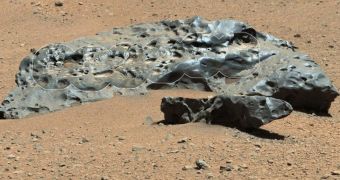This past July 15, NASA (the National Aeronautics and Space Administration in the United States) announced that its Curiosity rover had come across an oddly-shaped meteorite while exploring the Red Planet.
The meteorite, a photo of which is available above, appears to be made of iron. It is quite a big piece, and it is accompanied by a slightly smaller one that sits in its proximity and is visible in the foreground.
In a press release on the matter at hand, researchers with NASA explain that the Curiosity rover found this meteorite resting on the surface of the Red Planet some time ago, on May 25, i.e. its 640th Martian day.
Since then, astronomers have agreed to name the oversized chunk of meteorite Lebanon, and the smaller one close to it Lebanon B, NASA goes on to detail on its website.
Images obtained with the help of the Curiosity rover indicate that Lebanon measures approximately 2 meters (roughly 6.5 feet) in width and sports several cavities on its surface. Although smaller, Lebanon B looks strikingly similar.
Scientists theorize that Lebanon and Lebanon B ended up sporting these cavities following erosion processes. They also say that it is possible that the cavities were left behind by crystals that are now no longer part and parcel of their makeup.
“The imaging shows angular shaped cavities on the surface of the rock. One possible explanation is that they resulted from preferential erosion along crystalline boundaries within the metal of the rock,” NASA explains.
Furthermore, “Another possibility is that these cavities once contained olivine crystals, which can be found in a rare type of stony-iron meteorites called pallasites, thought to have been formed near the core-mantle boundary within an asteroid.”
Over the years, several other iron meteorites have been found on the surface of Mars. Scientists suspect that the reason why such meteorites are more common on the Red Planet than stone ones is because iron space rocks are more likely to survive erosion processes on this planet.
As NASA puts it, “On Mars, iron meteorites dominate the small number of meteorites that have been found. Part of the explanation could come from the resistance of iron meteorites to erosion processes on Mars.”
Iron meteorites have until now been discovered not just on Mars, but also on Earth. However, as is the case with space rocks whose presence has so far been documented on the Red Planet, iron meteorites tend to be few and far between on our planet.

 14 DAY TRIAL //
14 DAY TRIAL //